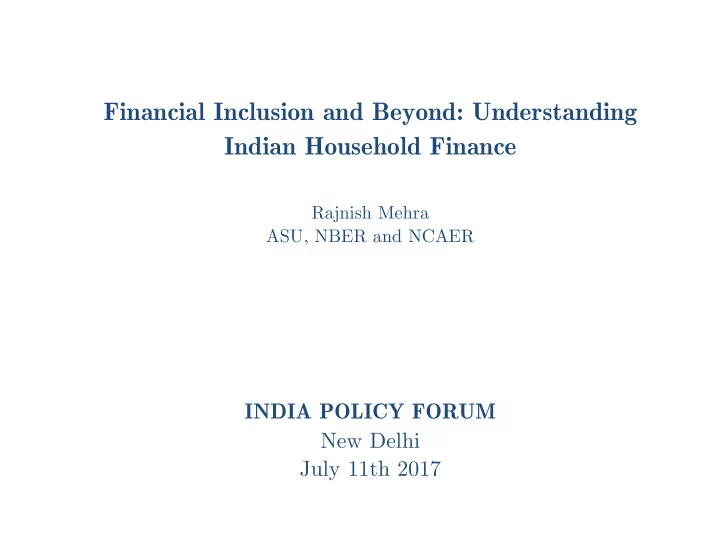

Financial Inclusion and Beyond: Understanding Indian Household Finance Rajnish Mehra ASU, NBER and NCAER INDIA POLICY FORUM New Delhi July 11th 2017
Financial Inclusion Access to instruments for consumption smoothing and risk sharing. § Instruments to save at a ‘reasonable’ real rate of return. § Instruments to borrow at non-usurious rates of return. § Instruments to insure against idiosyncratic shocks. 2
The poor are not a scaled down version of the rich. 3
Financial instruments that are appropriate for affluent consumers in developed economies may not be appropriate for poor households in developing economies. Providing access to these instruments may not result in financial inclusion. Fixed and transaction costs are of first order importance 4
Developed Complete Markets Complete Markets Not appropriate to Abstract from Fixed abstract from Fixed and Transaction costs and Transaction costs Poor Rich Incomplete Markets Incomplete Markets Abstract from Fixed and Not appropriate to Transaction costs abstract from Fixed and Transaction costs Developing 5
Financial inclusion (or the lack of) is not limited to developing economies. 6
Rapid advances in Fintech Traditional financial instruments are being redesigned Branch banking is being replaced Use of mobile money Smart cards (Airtel and MasterCard in Kenya) 7
Issues Specific to India 8
Financial Inclusion for Migrant Labor Given the regional imbalances in growth labor moves from less developed regions to economically better-off regions. As a result it is estimated that there are approximately 100 million migrants in India. Compared to agricultural households, migrants are characterized by high-risk occupations, erratic incomes and employment, shorter work life and early retirement. 9
Most migrants are employed in the informal sector with informal work contracts that do not provide insurance in case of accidents or occupational illnesses Need access to specialized financial products such as portable pension plans and disability insurance. However, the lack of a verifiable address is a major impediment for financial inclusion. Most rely on ‘hawala couriers’ – to transfer money at an estimated cost of 4.6% of the transfer amount. 10
Alternative Mechanisms for Financial Inclusion One kilowatt-hour of electricity costs about 25 cents if a household is connected to the grid. The same amount of electric energy from D-cells costs $50. This imposes a huge transaction tax on poor households that do hot have an electrical connection. Lack of access to electricity has consequences that affect all aspects of life. In addition to the adverse impact on productivity, education, health and security, it is essential for powering mobile phones network connectivity – two essential concomitants for providing ‘traditional financial inclusion’ 11
“ There are many different ways to affect financial inclusion. Most people think immediately of things like microloans, bank accounts and credit cards. We saw the need to create a financial product that is designed for the energy poor, a financial solution that can help make clean, reliable electricity affordable for the mass market.” Paul Needham Founder of Simpa 12
Simpa sells small solar powered home systems that power a couple of LED lights, an electric fan and a mobile phone charger. No fixed cost. Pay as you use system. The household manages the payment on his mobile phone. Each payment for energy adds towards the final purchase price. Typically after two years, the system is fully paid for and the household owns the system. 13
Holding Gold: An Optimal Response to Expropriation? The travelogues of Jean-Baptiste Tavernier and François Bernier provide a detailed description of life in the Mughal court. The Mughals employed the ‘Mansabdari System’ A feature of this system was that the property and title of a mansabdar was confiscated after his death. His widow and children had to start life from scratch. This lead to perverse incentives and mansabdars became experts in the art of concealing wealth, largely in the form of gold and precious stones. 14
Recommend
More recommend